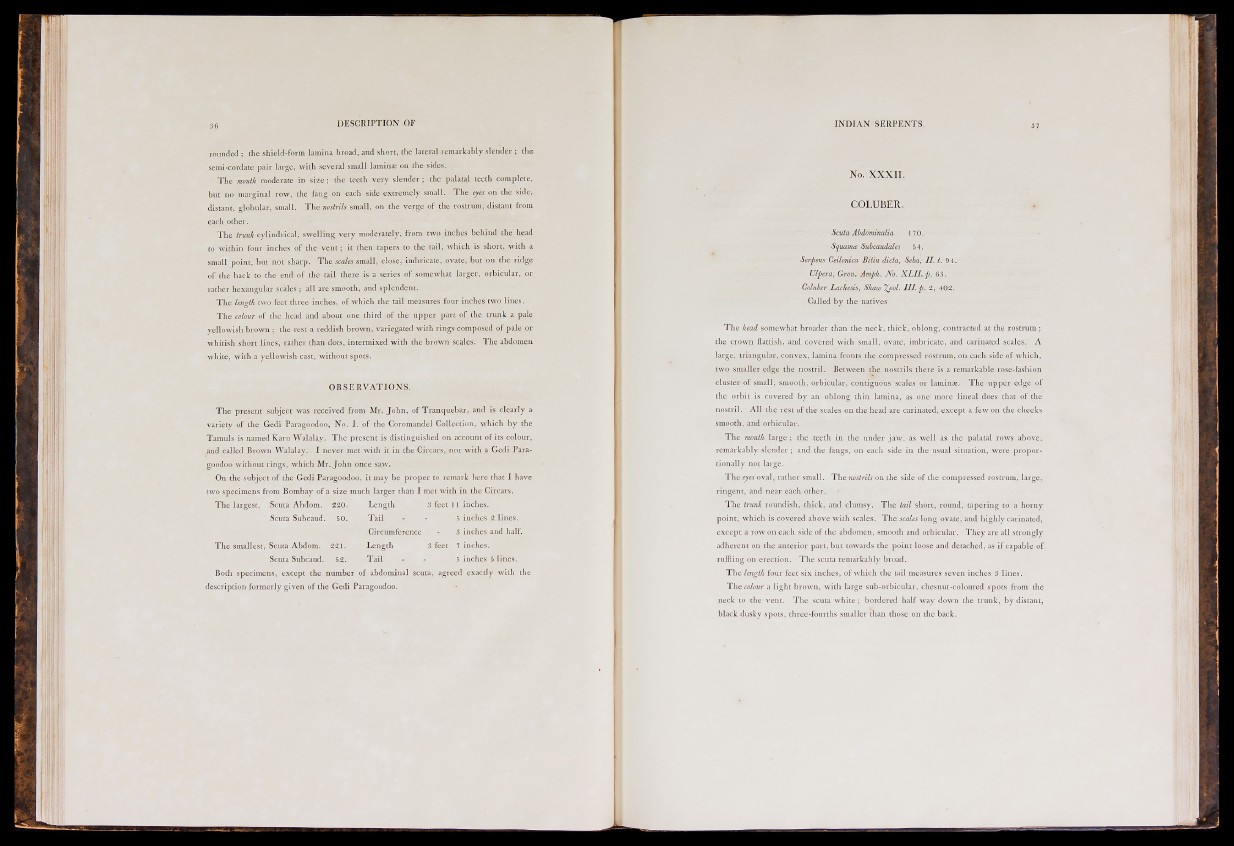
36 DE S C R I P T ION OF
rounded ; the shield-form lamina broad, and short, the lateral remarkably slender ; the
semi-cordate pair large, with several small laminie on the sides.
The mouth moderate in size ; the teeth very slender ; the palatal teeth complete,
but no marginal row, the fang on each side extremely small. The eyes on the side,
distant, globular, small. The nostrils small, on the verge of the rostrum, distant from
each other.
The trunk cylindrical, swelling very moderately, from two inches behind the head
to within four inches of the vent; it then tapers to the tail, which is short, with a
small point, but not sharp. The scales small, close, imbricate, ovate, but on the ridge
of the back to the end of the tail there is a series of somewhat larger, orbicular, or
rather hexangular scales ; all are smooth, and splendent.
The leno-th two feet three inches, of which the tail measures four inches two lines.
The colour of the head and about one third of the upper part of the trunk a pale
yellowish brown ; the rest a reddish brown, variegated with rings composed of pale or
whitish short lines, rather than dots, intermixed with the brown scales. The abdomen
white, with a yellowish cast, without spots.
O B S E R V A T I O N S .
The present subject was received from Mr. John, of Tranquebar, and is clearly a
variety of the Gedi Paragoodoo, No. I. of the Coromandel Collection, which by the
Tamuls is named Karu Walalay. The present is distinguished on account of its colour,
and called Brown Walalay. I never met with it in the Circars, nor with a Gedi Paragoodoo
without rings, which Mr. J o h n once saw.
On the subject of the Gedi Paragoodoo, it may be proper to remark here that I have
two specimens from Bombay of a size much larger than I met with in the Circars.
The largest. Scuta Abdom. 220. Length 3 feet 11 inches.
Tail - - 5 inches 2 lines.
Circumference - S inches and half.
Length 3 feet 7 inches.
Tail - - 5 inches 5 lines.
Scuta Subcaud. 50.
The smallest, Scuta Abdom.
Scuta Subcaud.
Both specimens, except the number of abdominal scuta, agreed exactly with the
description formerly given of the Gedi Paragoodoo.
I N D I A N SERPENTS.
No. XXXII.
COLUBER.
Scuta Abdominalia 170.
Squamie Suhcaudales 5 4.
Serpens Geilojiica Bitin dicta, Seba, II. ¿.9 4.
Vipera, Gron. Amph. No. XLII. p. 63.
Coluber Lachesis, Shaw Xpol. III. p. 2, 402.
Called by the natives
The head somewhat broader than the neck, thick, oblong, contracted at the rostrum ;
the crown flattish, and covered with small, ovate, imbricate, and carinated scales. A
large, triangular, convex, lamina fronts the compressed rostrum, on each side of which,
two smaller edge the nostril. Between the nostrils there is a remarkable rose-fashion
cluster of small, smooth, orbicular, contiguous scales or lamina;. The upper edge of
the orbit is covered by an oblong thin lamina, as one more lineal does that of the
nostril. All the rest of the scales on the head are carinated, except a few on the cheeks
smooth, atrd orbicular.
The mouth large ; the teeth in the under jaw, as well as the palatal rows above,
remarkably slender ; and the fangs, on each side in the usual situation, were proportionally
not large.
The eyes oval, rather small. The nostrils on the side of the compressed rostrum, large,
ringent, and near each other.
The trunk roundish, thick, and clumsy. The tail short, round, tapering to a horny
point, which is covered above with scales. The scales long ovate, and highly carinated,
except a row on each side of the abdomen, smooth and orbicular. They are all strongly
adherent on the anterior part, but towards the point loose and detached, as if capable of
ruffling on erection. The scuta remarkably broad.
The Icjigth four feet six inches, of which the tail measures seven inches 3 lines.
The colour a light brown, with large sub-orbicular, chesnut-coloured spots from the
neck to the vent. The scuta white ; bordered half way down the trunk, by distant,
black dusky spots, tliree-fourths smaller than those on the back.